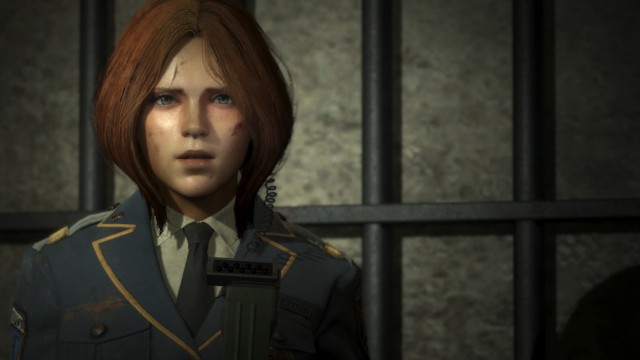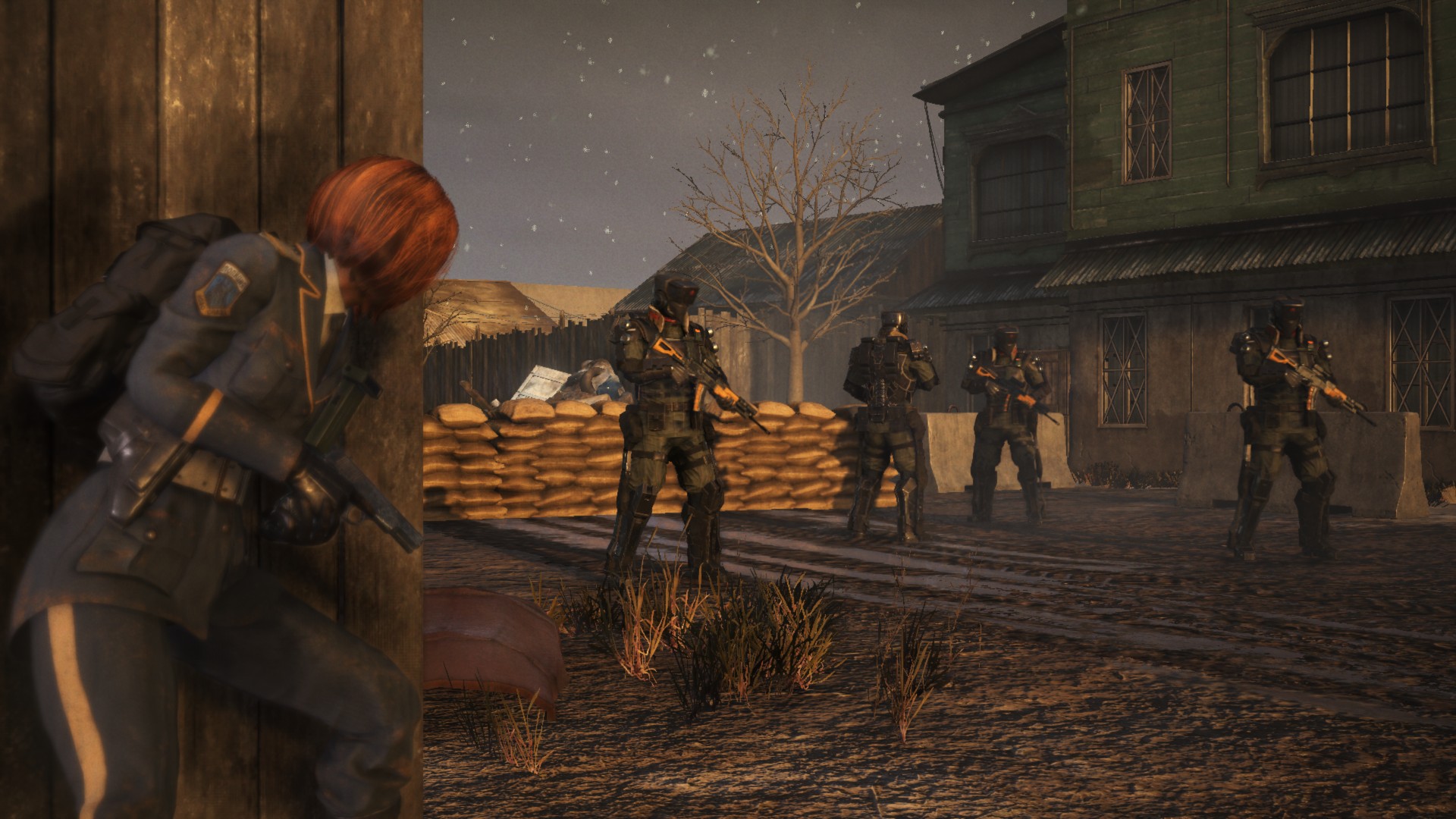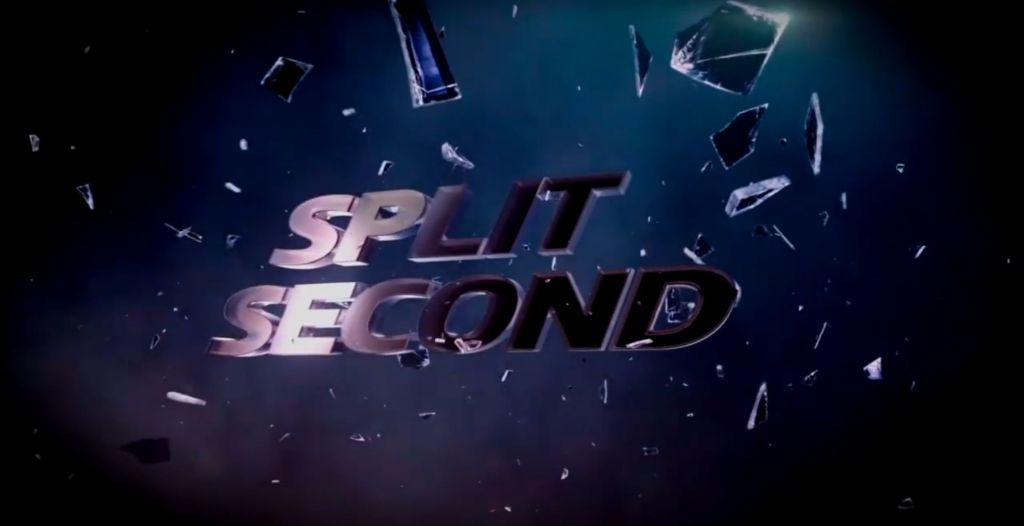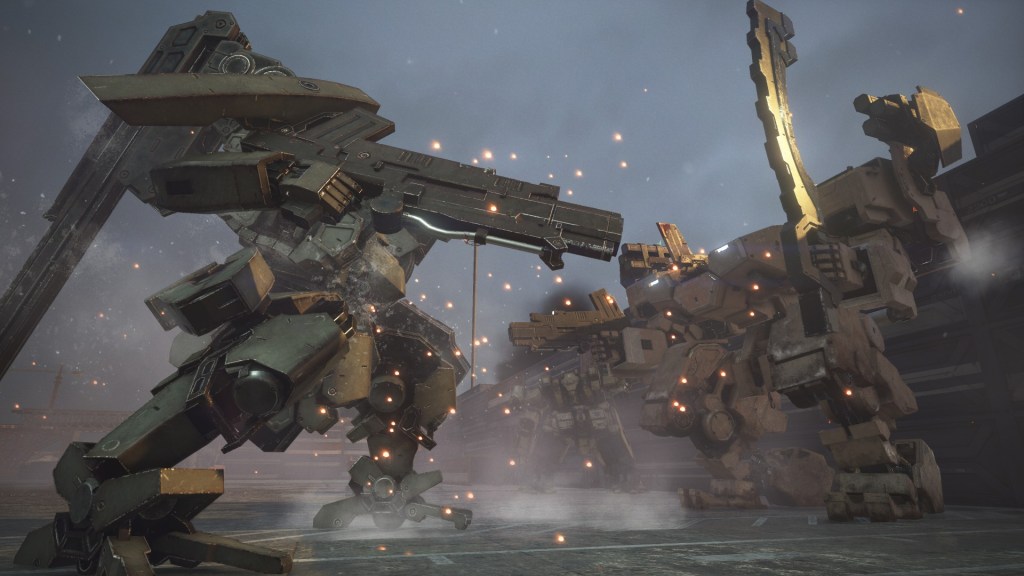If a single glance at the cover of Left Alive summons a sense of familiarity and history, that might be because it is graced by the art of Yoji Shinkawa, Metal Gear Solid’s lead character designer. And Left Alive, the Square Enix stealth action game releasing March 5th, is part of a long franchise… just not the one the cover art might suggest.
In fact, Left Alive is the the latest game in the long running, and frustratingly underappreciated, Front Mission series, which began with the eponymous tactical RPG Front Mission on the Super Famicom in 1995 and which last saw an entry in Front Mission Evolved, a much-maligned action game from 2010.
Videos by VICE
If you don’t know about Front Mission, well, I sadly can’t blame you, as the series rarely found much purchase outside of Japan. But hopefully this article can prep you to step into the city of Novo Slava next week, giving you an understanding of the history of Front Mission, both as a unique game series and a fictional world.

Front Mission is, of course, best known for its “Wanzers,” bipedal mechs that feel more like walking tanks than the high flying super machines of games like Xenoblade Chronicles X or Armored Core 4. But Front Mission’s most distinctive feature was how it used war as a stage for technothriller stories. This made it the cousin of near-future science fiction series like Metal Gear and Ace Combat: full of shadowy masterminds, false flag operations, the overwhelming presence of global communication technology, and troubling stories of the uses of biotechnology and AI. The series’ technothriller focus, influenced by the original works of Tom Clancy in the 1980s, set Front Mission apart from other giant robot properties, and made the collaboration of former Front Mission and Metal Gear creators on Left Alive an understandable project.
The series therefore broke cleanly with the space opera roots of giant robot fiction. While it was obviously inspired by the work of Kunio Okawara (designer for such series as Votoms, from which Front Mission lifted its iconic roller dashing), it took its roots in military science fiction and wargaming and turned them towards near future real world settings. This was much like what Clancy had done with his own work, and it carried the same hallmarks of late 20th century obsession with tech and communication. But Front Mission was not just a direct Japanese imitation of Clancy’s work. Front Mission was a series with its own voice.
The stories it told were warrior fantasies, but they owed as much to anti-Vietnam War fiction as they did to Clancy’s mythos of Reaganite jingoism. The warrior heroes of these games were often not soldiers, instead being civilians and guerillas of various types who were forced to take up arms. There was as much of post-Vietnam persona of the war reporter speaking truth to power on display in these games as there was the Clancy-esque independent soldier.
Some of the Front Mission stories even bore a resemblance to le Carré’s work of the 1990s, focusing on corporate and institutional abuses of power. The fantasy of the typical Front Mission hero is that they are able to arm themselves, get a grasp of the broader webs of power and conspiracy they confront, and use their capacity for violence to cut through those webs to set things right in a way soldiers implicated in a vast modern military machine rarely can. There is an air of Edward Snowden with a giant robot to each of them.

In the context of Japanese RPGs, Front Mission was also set apart by having protagonists who are adults with careers and distinct social standings, not teenagers with the leveling social status of students and given fortuitous access to devastating high tech weaponry. This was not necessarily uncommon in real robot stories like Votoms, nor in technothriller genre stories, but it set Front Mission well apart from most JRPGs.
Furthermore Front Mission was unusual because of its international orientation, its creators really had an interest in the world around them. The series was certainly shaped by the prejudices of a Global North perspective, but it never centered Japanese characters above those of other nationalities in the way that, say, Marvel comics tend to treat their American heroes as the center of their stories and view the narratives through their perspective.
The Series
Okay, but what happens? Below, I’ve outlined the history of Front Mission’s world and story. It spans an extensive connected timeline, and one which has largely remained inaccessible outside of fan translations. The series timeline is presented in order of the world chronology instead of order of release, for clarity’s sake. Spin-offs and minor entries have been omitted for brevity’s sake. And, heads up: All sorts of spoilers below!
Front Mission (2089-2092, released 1995, 2003, 2007)
Originally released on the Super Famicom, Front Mission had subsequent re-releases that added to its story up until its final release in 2007 on the Nintendo DS. It was the foundational text for the series, establishing its world of competing superstates, and the tactical RPG gameplay that most entries in the series would expand on and refine.
The original game followed the story of Royd Clive, an Australian soldier serving in the military of the Oceana Community Union (OCU), a group of states along the western Pacific Rim, including Japan and Australia. Clive’s unit is pulled into a false flag operation set up by a group of multinational conspirators that incites war between the OCU and the American-lead USN over Huffman Island, a large island in the middle of the Pacific created by volcanic activity and claimed by both nations.
After becoming a pariah for starting the war, Clive turns to the mercenary life, and is quietly recruited by the OCU to lead a special mercenary unit that spearheads the war against the USN. As the game progresses Clive and his fellow mercenaries discover the truth of the conspiracy that started the war, and how it combined various aims of personal advancement, national revanchism, and corporate profit seeking across borders.
This conspiracy aimed to test a new high performance series of mecha CPUs controlled by the harvested brains of wanzer pilots, introducing the series’ first example of biotechnological horror. Clive’s mercenaries eventually destroy the conspirators, and his journalist companion breaks the scandal to the world, but Royd is left a broken man who spirals into bitterness and despair until his death at the hands of the player characters in Front Mission 2.
Front Mission 4 (2096-2097, released 2003)
Front Mission 4 was a mid-cycle PlayStation 2 tactical RPG that struggled to distinguish itself on any level, suffering from a rushed production schedule. It was developed alongside the 2003 PlayStation remake of Front Mission and the 2005 online shooter Front Mission Online as part of a large scale “Front Mission Project” initiative, with the aim of expanding the story of the original game. Like the Front Mission remake, it told a war story from the perspective of groups on both sides, but its drab graphics and uninteresting characters, especially on the European side of the game, weakened the attempt to create a multi-dimensional story.
Jumping back in the timeline, Front Mission 4 followed up on the story of the first game, showing how Zaftra (a revanchist Russia, and one of the major conspirators from Front Mission) tries to pull the same trick twice by pitting the USN and EC (essentially our European Union) against one another using false flag operations. A multinational European unit, the Durandal, and a rag-tag bunch of USN soldiers doing policing duty in Venezuela end up working together to foil the Zaftran plot.
The USN side of the story was by far the more interesting, as Front Mission 4 was the only game in the series to highlight independence struggles against the USN, and included guerilla independence fighters as characters with relatable motivations beyond the abstract machinations of international politics. In light of the conflict over the future of Venezuela currently happening, those themes feel especially relevant today.
Front Mission 2 (2098-2102, released 1997)
Like Front Mission 4, the second game in the series finds its strengths in exploring the dynamics of imperialist exploitation and the dilemmas of independence struggles, but unlike its sequel , Front Mission 2 is clearly focused on this topic and gives it a deeper and more considered treatment. With three interwoven narratives and very strong themes, the second game in the series was arguably its narrative high point, but it was hamstrung by technical problems so deep that they are difficult to overlook.
The story of Front Mission 2 was outstanding. It is one of the few games ever made to take place in Bangladesh (renamed Alordesh), and grapples with the problems of decolonization and deindustrialization.
After the events of Front Mission, the OCU has fallen into internal chaos, with nationalist ambitions of many of its member states being barely suppressed by the Union’s federal government. The flashpoint for this conflict ends up being Alordesh, a country that was promised prosperity for joining the Union, but was abandoned to rust after the economic boom times of the past had gone.
The game opens with a cinematic of rusted and decaying machinery, and everywhere you visit in the game feels dismal and squalid. It never misses an opportunity to point out that this is a conflict primarily motivated by terrible material conditions, and fought over because of differing material interests. Its story of a coup d’etat organized by the Alordeshi officers corp is reminiscent of the politics of the 1970s, but it brings those events into the context of globalization and ominous AI technologies developed through the exploitation of the Global South. Towards the end of the game, the story tends to collapse into Clancy-esque techno thriller tropes, but as a whole it is a real and notable accomplishment that subsequent games have rarely matched.
The game opens with a cinematic of rusted and decaying machinery, and everywhere you visit in the game feels dismal and squalid.
At a technical level, Front Mission 2 is an exemplar of PlayStation era overambition. It strove to have massive wargame-style battles that would put the strategy in “strategy RPG,” alongside brief 3D cinematic cutaways to show the giant robots slug it out and maintain the player’s interest. The problem was that these cinematic interludes and excruciatingly long load times actually made the game grind to a snail’s pace and drew the battles out into long hour-plus affairs, with no mid-mission saving allowed.
The game’s strategic scope helped to bring the picture of a country in devastating civil war to life, but it also meant that the player could make early battle blunders that would cause them to fail the mission 45 minutes in with no recourse to address their mistakes. It is a challenging game that rewards persistence and careful thinking, but it’s not hard to imagine why Squaresoft decided not to localize it for foreign audiences. Of all the games in the series, it is undoubtedly the one that would be best served by a full remake.
Front Mission 3 (2112-2113, released 1999-2000)
It is easy to heap scorn on Front Mission 3 because of its introduction of misplaced shonen anime tropes to the series and often weak story beats, but in retrospect it is clear that it attracted the interest of Western audiences not only because it was the first game in the series to be sold outside Japan, but because of real strengths.
Front Mission 3 is primarily a road trip story, with the protagonists hopping from country to country in pursuit of the game’s MacGuffin, a nuclear weapon stolen from the USN called MIDAS. MIDAS is stolen and stolen again by various self-interested actors, and it’s up to the heroes of the story to track it down and put an end to it. Alongside this main plotline is the story of genetically engineered super soldiers from the Eastern European Republic of Ravnui meddling in international conflicts, and the story of the OCU unravelling after Alordesh gains independence in the wake of Front Mission 2. The accomplishments of this broadest of entries in the series are all the more clear in comparison with Front Mission 4, which had more modest storytelling goals and could not achieve them with anywhere near the same degree of flair and aplomb.
While its micro-level storytelling was often weak compared to its predecessors, Front Mission 3 managed to weave together three main storylines across two alternate timelines and a setting that stretched around much of the Pacific Rim. Additionally, it improved enormously on the technical problems of Front Mission 2, and returned to a focus on tactical combat that was snappy and dynamic rather than plodding and anxious. Front Mission 3 also featured incredibly impressive world building, facilitated through its “Network” feature, a mock World Wide Web that acted as the game’s lore codex, and which was updated dynamically as events progressed in the game, bringing the Front Mission world to life.
Front Mission 5: Scars of the War (2070-2121, released 2005)
Front Mission 5 is a strange beast. Despite its impressive visuals based on an upgraded Final Fantasy X engine and solid turn based tactics play, it never was localized for western audiences until the Front Mission Fan Translation Project (of which I was a part) released a translation patch in 2009. Looked at one way, it’s such a meta-narrative about the whole series that preceded it that nobody without hundreds of hours invested in the earlier Front Missions would get much out of it. But looked at another way, it’s actually one of the most straightforward stories in the Front Mission series, to the point that it feels somewhat unsatisfying in comparison to a game like Front Mission 2.
Front Mission 5 relies to a large degree on audience knowledge of referenced context. This is because it spans the majority of the lifetime of Walter Feng: a USN soldier who starts out as a war orphan due to the events that form the background of the first Front Mission, and ends up as a father, a commander of an elite mecha unit, and a war hero decorated many times over after Front Mission 3 has ended.
Walter acts as the focus that allows the player to revisit almost the entire series timeline, and the game was therefore a kind of last hurrah for the longtime developers of the series before they left the company and scattered across the Japanese games industry. At its most basic, the game is the story of people who are abused by the military-industrial complex and try to overcome their trauma while continuing to wage war. Like many JRPGs, it’s a story of how love and friendship can overcome any degree of adversity, even if there are heartbreaking sacrifices along the way. The relationship between Walter, his love interest Lynn Wenwright, and his close friend Glen Duval works at this level. It’s where the antagonist Morgan Bernard is introduced that the game becomes difficult to parse.
Within the strict textual limits of the game Bernard comes off as little more than an unmotivated evil, making grandiose speeches about the meaninglessness of existence and transcending the human form. In this sense, the most flattering comparison that could be made for Bernard is to Mission: Impossible’s Solomon Lane, an international anarchist mastermind who mostly plays his role and gets out of the way of the action on screen.
However Bernard is a more understandable character when given series context. He was first introduced in Front Mission Zero, a manga that was published alongside Front Mission in 1995, and which was so obscure it wasn’t even given a reprint in Japanese when Front Mission 5 was released a decade later. Bernard is depicted in the manga as an altruistic and brilliant doctor, whose attempts at humanitarian aid are crushed by the inhuman interests of superstates like the EC. This sets him on a much more clearly motivated campaign of international terrorism to try to undermine the organizations that ruined his life and dreams.
Bernard then appears as the inventor of the mecha CPUs at the heart of the conspiracy in Front Mission, the bankroller of the pro-independence coup d’etat in Front Mission 2 and the pro-independence guerillas in Front Mission 4, the first person to attempt to use MIDAS from Front Mission 3 for his own nefarious ends, and in Front Mission 5 combines the super weapons introduced in the first game and Front Mission 2 to create an international network of terrorist AIs aimed at destroying the superstates once and for all.
The implication is that Walter Feng suffered similar trauma to Bernard in his life because of the international military industrial complex, but what made Walter different was being able to find a different path through love and friendship that prevented him from being twisted in the same ways Bernard was by his experiences. Walter was able to overcome “the scars of the war” that tormented him and become a hero rather than a villain.
Created at the height of the War on Terror, the implications of this story are troubling. It suggests that the “counter-terrorist” cause of the United States war machine is fundamentally just even as it acknowledges the terror that it inflicts both on civilians around the world and its own personnel. Like Clancy, it resorts to the myth of “one good man” who represents true American values, and can set the ship aright when confronted with the injustices these enormous institutions of violence inflict.
It is perhaps understandable that like the Final Fantasy team who left Square Enix before them, the creators of Front Mission wanted to created a magnum opus that would end their careers with the company on a note of triumph, but that note actually sounds sour on even the most expansive and informed reading. The last cutscene of the game has Walter going to induct his daughter into the next generation of soldiers—the scars of past wars erased and the future bright with men like him to protect it. The contrast to Royd Clive’s earlier descent into villainy as a result of the trauma he suffered and ignominious death could hardly be starker. In its last moments Front Mission seems to lose all critical distance and simply embraces the mythology promoted by Pentagon PR.
There is no doubt that Front Mission 5 is the most mechanically polished game in the series, but it also compromises what had made the series interesting in the past.
Front Mission Evolved (2171, released 2010)
Front Mission Evolved was a deeply troubled project that was handed over to Double Helix in one of Square Enix’s early outsourcing missteps, and received almost no input from the original Front Mission development team (With the exception of producer Shinji Hashimoto, who has returned as producer on Left Alive). It attempted to imitate the mix of on foot and in mech gameplay found in the series spin off Front Mission: Gun Hazard for the Super Famicom, and it appears that Left Alive is once again attempting to modernize this formula within the mainline Front Mission story. With Motomu Toriyama leading writing on the game it veered well off tone, ending with a climactic battle against a robot space tree that evolved from the technology Bernard had developed back in the older games.
Just about everything about this game felt off, from the mechanical designs to the complete lack of a sense of place to its locales. As a corridor shooter, a giant robot game, and as a Front Mission entry it has almost nothing to recommend it. The question hanging over Left Alive is whether or not the passage of time, and the assembly of a group of creators more closely connected to mecha games can successfully carry on the series in a way Front Mission Evolved could not.
Left Alive
Setting the doubts that Front Mission Evolved casts over the game aside, what does the history of Front Mission suggest about Left Alive? It is set in the region of the present day Ukraine, six years after the end of Front Mission 5, and the game seems on intent on depicting themes taken from the Euromaidan events of 2013 and the Russian annexation of Crimea in 2014.
On the face of it this is perfect fodder for a technothriller game in the Front Mission style, but there is perhaps a lack of excitement for the game that comes not from its lack of focus on mecha, its breaking with turn-based tactics, or its PS3 style graphics, and rather from exhaustion with the technothriller conceit as, like cyberpunk, it more and more simply depicts a familiar reality.

Unlike the work of le Carré that thrived off the actually existing Cold War, the genre that Clancy pioneered always thrived off of “what if?” scenarios that pitted various whiz-bang war technologies against each other. In a world where we all live under the shadow of Facebook and the NSA’s PRISM technology, where any political event will be attributed to PSYOPS by just about any stratum of society, from the most marginalized to the most elite, where the world lurches drunkenly towards multipolarity, and where mass politics seems caught in an intractable web of digital misrepresentation, there simply isn’t any “what if?” left to titillate in the technothriller conceit.
Perhaps Left Alive will be the mecha version of Adam Curtis’ Hypernormalisation, and try to say something about this general state of affairs, but it seems more likely to only show us something dismally familiar. What’s a wanzer to do?
More
From VICE
-

Screenshot: HBO -

Screenshot: Xbox Game Studios -

Screenshot: Steel City Interactive -

Screenshot: Disney Interactive Studios
